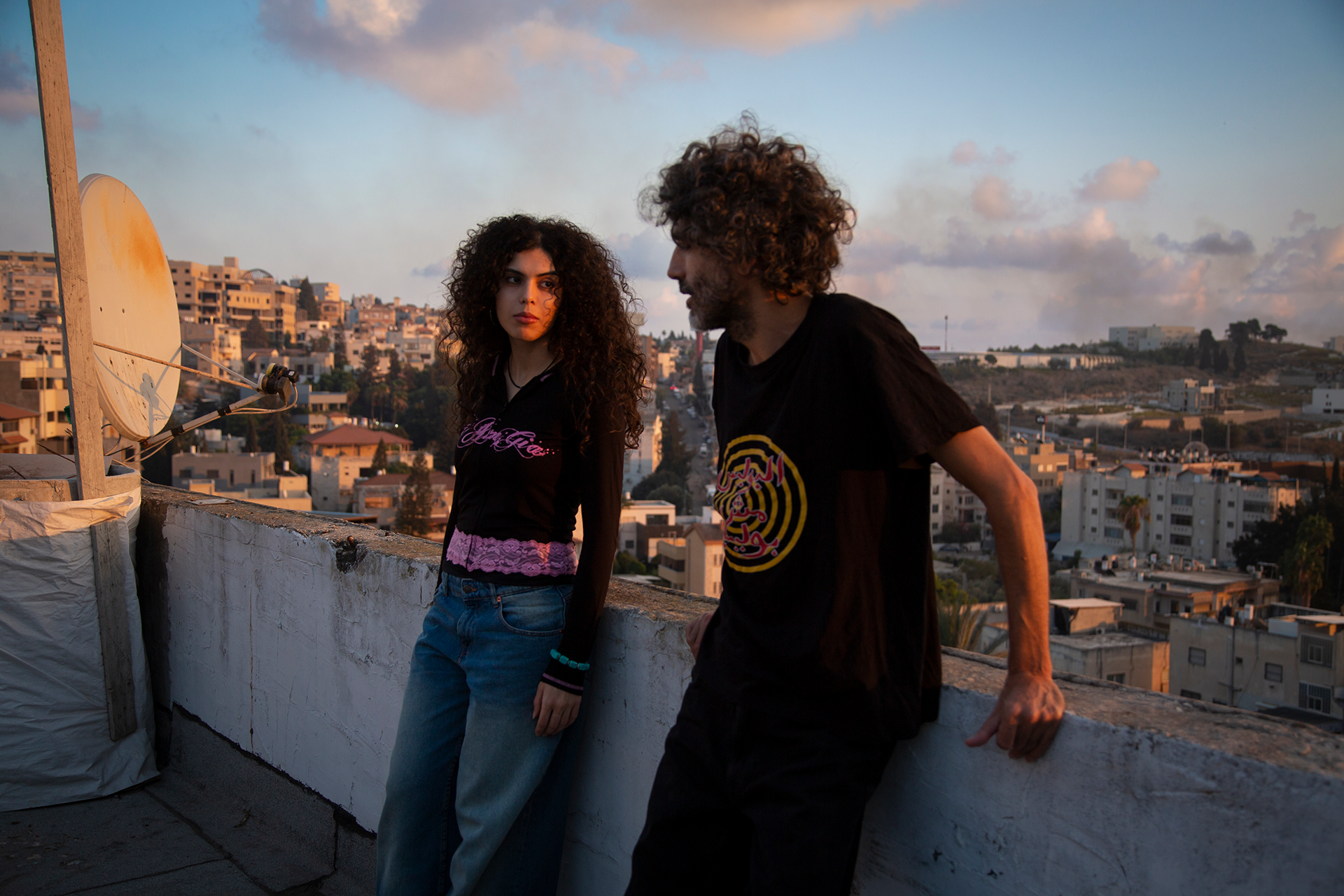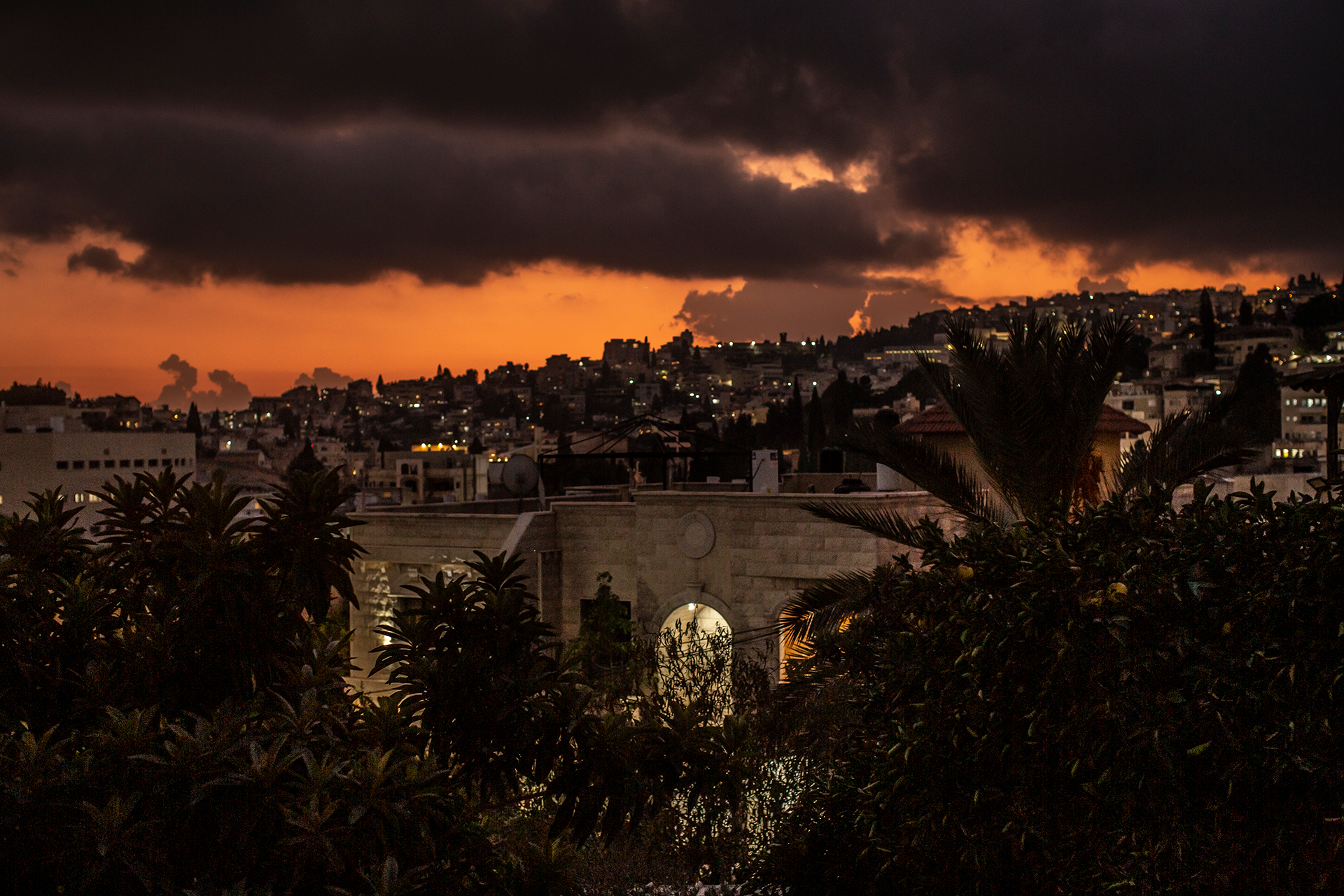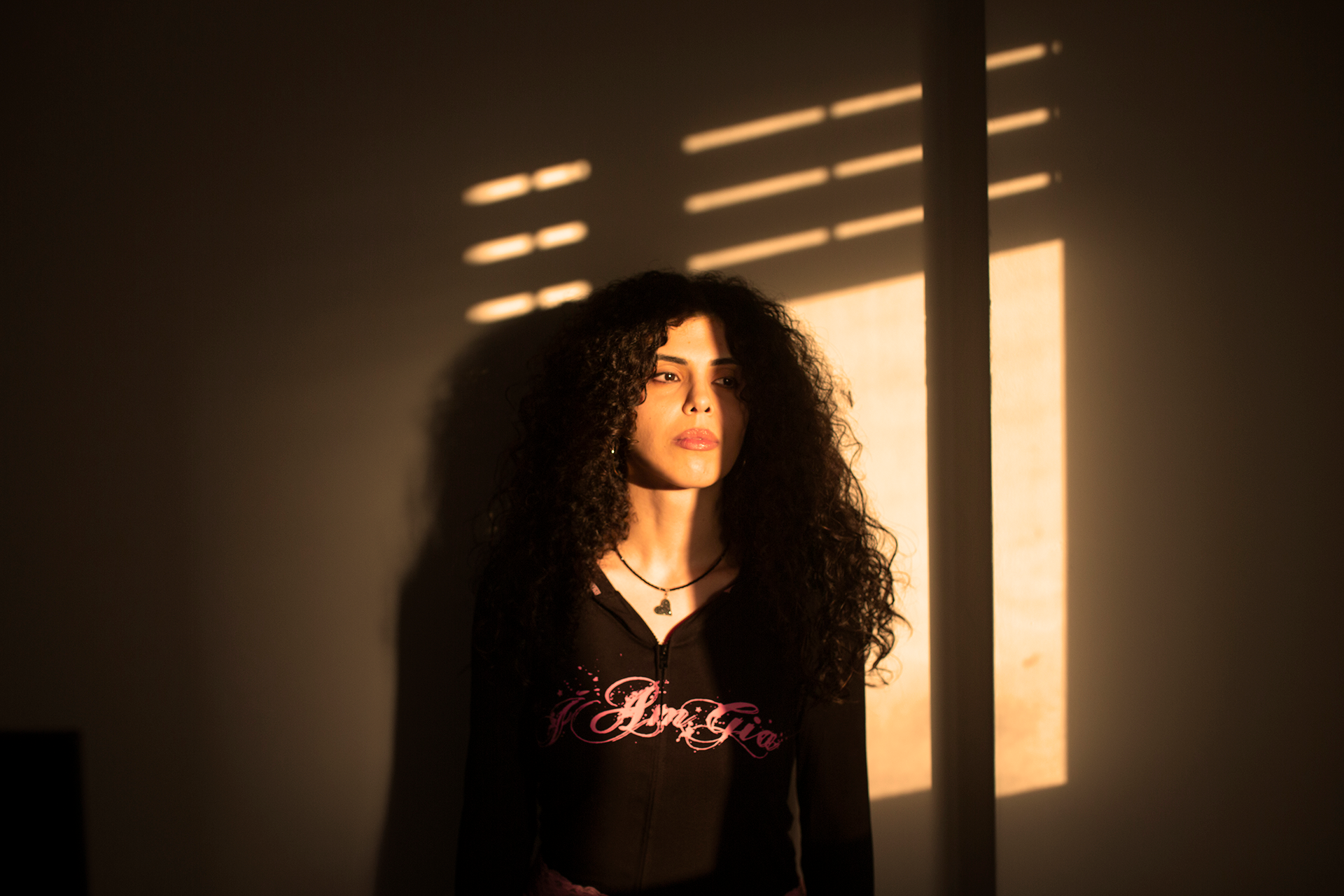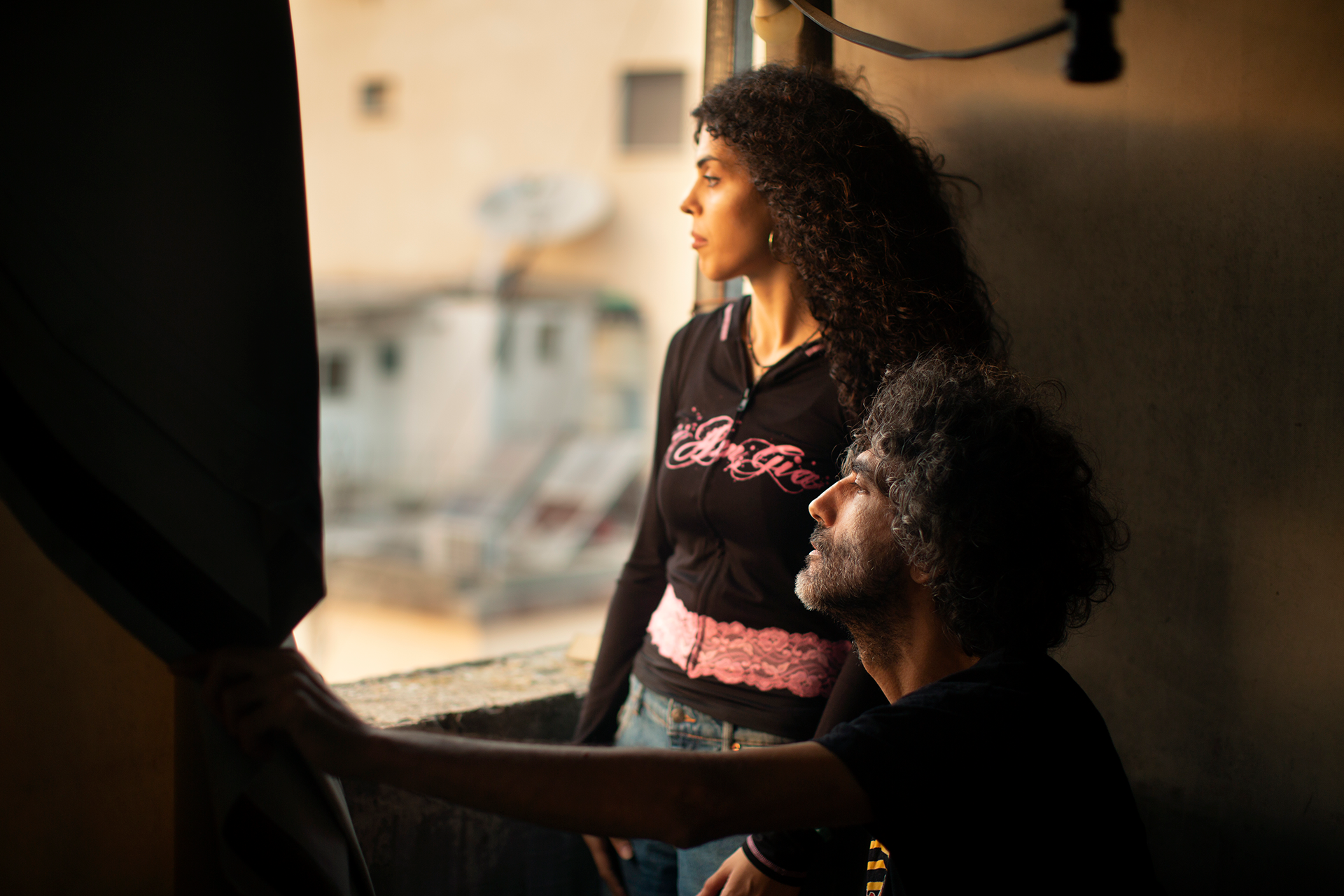Palestinian Art During Genocide: An Interview with Jowan Safadi and Haneen Odetallah
By Aicha Yassin

Cover art by Yasmine Omari
A couple of weeks ago, Jowan Safadi, a well-known Palestinian musician and artist, posted a portrait of himself on social media. In an uncanny resemblance to Jesus with a thorny wreath, he announced the title of his latest single: “I am the Semite.” In the description, he confessed: “I know it’s not the right time for songs/ but this might be the right song for this time/ I hope it helps.” The song counter-argues the blanket accusation that every criticism of Zionism is anti-Semitic and flips the argument on its head, arguing that Jews are not the only Semites; we Palestinians are Semites too. As the lyrics go: “I am the Semite that still has to face/ white people wipe his people and take their place/ demonize their race.”
The song echoed through pro-Palestine solidarity encampments around the world, especially in the US. Besides the pithy lyrics, Jowan’s statement about the right timing to share his music exposes a sensitive topic that has been the center of discussion among Palestinian artists and intellectuals: what role does art play during times of genocide? Which art forms are deemed acceptable and relevant in such a context?
Last month, I met with Jowan and his partner, Haneen Odetallah, a Jerusalemite writer and cultural critic, in Nazareth. What struck me about this creative couple is their immense sense of responsibility and unwavering determination. They are resolute in resisting the occupation through their art, whether it's by writing protest music or publishing political and cultural articles.
Belly of the Beast
The dissonance between producing art and the atrocities of the live-streamed genocide in Gaza and the brutal annexation of the West Bank is tangible in our conversation. In the 48 Palestinian lands, institutional censorship adds to an already complex reality. We are in the belly of the beast. “This state of dissonance and emergency is not new to us; we have always been in a survival mindset, but now it’s condensed and exacerbated,” Haneen says calmly. “That’s why we consult a lawyer before we release any song. We feel obligated to say something, but we’re also careful and strategic about what we say,” Jowan adds seriously.
Jowan, known for his satirical music and sarcastic lyrics, admits he’s more serious nowadays. Since the onset of the genocidal war, he has been more careful about what kinds of jokes he makes. “I believe that there’s value in humor, especially as a way for the oppressed to mock the oppressor and disrupt the power dynamic, but right now, it is so difficult to conjure up humor,” he admits with a bittersweet smile.

Photography by Yasmine Omari
Our socio-political reality forces us to bear witness to absolute, unbridled horror in Gaza and the West Bank while living around the corner: Jenin is less than an hour's drive away from Nazareth. The proximity of two different realities, one where people suffer a brutal incursion and the other where people celebrate at wedding parties, can be dizzying. Once the disorientation subsides, the burning question becomes painfully clear: are we next? Palestinians inside 48 might have been spared the heavy bombardments and incursions, but instead, they deal with more silent killers lurking in the shadows of organized crime. Jowan’s 2022 single “Al Jarima” addresses the Palestinian mafia issue and how it cuts through our communities' social fabric. Since the beginning of this year, there have been 165 Palestinian deaths related to organized crime. Jowan and Haneen finish each other's sentences when they describe the ailment of our society: “We suffer from social disintegration, designed and propelled by the Israeli occupation since 1948. Through negligence, neoliberal and racist policies, and land theft, they managed to turn our towns into ghettos. This social disintegration influences the art we produce and increases our sense of responsibility towards our community.”
The Politics of Art
Throughout history, Palestinian artists and intellectuals have played a significant role in confronting the occupation. Our artistic productions are inherently political; they seemingly have no choice but to be part of what Kanafani called “resistance literature.” The Palestinian writer is often simultaneously a politician, activist, and revolutionary. Hence, engaging with Palestinian art as an artist or audience requires a conception of the political and social context in which it is conceived.
In an early 2000 interview, Mahmoud Darwish was asked by Nabeel Amr about the reception and interpretation of Palestinian poetry in the Arab world. Darwish told his interviewer he wished for the Palestinian people “to be normal people under abnormal circumstances.” Aware of the deprivation of normalcy under occupation and the insistent reality of oppression, his desire for the ordinary is, in fact, a suggestion of alternative heroism. It is a way for Palestinians to liberate themselves from a binary myth that requires them to be either heroes or victims.

Photography by Yasmine Omari
With the continuous and relentless onslaught against our people, it’s challenging to observe Darwish’s call for normalcy. Haneen and Jowan are indebted to Darwish and heed his wish by incorporating the occupations’ suppression in their art: “Censorship in itself is a material that we work with. It’s part of the material conditions that constitute our reality and thus can be employed to serve our art or be overcome by it”. While daunting, their suggestion echoes Darwish’s grounding words. It is the same kind of pivotal value that Haneen and Jowan hold on to: “Your art is what you’re living, and if you’re censored, then that’s another layer of your experience to create art.”
Artistic Resistance
Palestinians have had to come up with ways to defeat censorship through art. The examples are numerous, but the Palestinian folk song, يا طالعين عالجبل (“Hey, you, climbing up the mountain”), might be the most captivating. The song was sung by Palestinian women in the 19th and 20th centuries on their way to visit men held captive in Ottoman or British prisons. By repeating certain syllables and sounds, known as al-malwa’lala, they delivered hidden messages to the prisoners about their imminent liberation. Re-releases of the song by beloved musicians Rim Banna and Reem Kelani, and more recently, Dana Salah, reveal the continued importance of this famous resistance lullaby. Salah's hit song and re-release “Ya Tala3een” has reached over 4 million views on YouTube.
When asked about the risk of Palestine becoming just another viral trend, Haneen smiles, saying: “As long as it helps garner more attention and support, then it doesn’t hurt. But it’s part of our duty to turn that momentum into meaningful, lasting action.” Jowan chimes in: “Each contribution that helps us is welcome, but obviously, it depends on the artist’s intention. Even more than political slogans, I expect authenticity from any artist who wants to address or relate to the Palestinian cause. I think this authenticity is reflected in the work itself. If the artist is not genuine, I can feel it.”

Photography by Yasmine Omari
Recently, they published their first song together, “هذا الوحش” (“This Monster”), the title of which is a direct quote by Mahmoud al A’arda, the mastermind behind the escape of six Palestinian prisoners from Gilboa’s prison on Sep 6th, 2021. In May of that same year, a popular uprising within historic Palestine took place as a response to the Sheikh Jarrah eviction orders and Gaza’s bombardment. In the weeks that followed, Israel conducted massive arrest campaigns throughout Palestine, charging young Palestinians with five to fifteen years of prison sentences. The ensuing collective despair was lifted briefly by the news of the six prisoners who had escaped one of the occupation’s most fortified prisons with nothing but a spoon.
Haneen and Jowan attended the last trial of the prisoners after they were recaptured. Once the verdict was issued and the prisoners were isolated and behind bars again, the couple came home devastated. Out of pain and a desire to pay tribute to this event and the prisoners, Haneen composed the song’s core verses, which the couple developed into its final form. They immediately broadcast the song on the prisoners’ radio station, so they were the first to hear it.
As a cultural analyst and academic researcher, Haneen knows her Palestinian prisoners’ literature. Her latest article analyzes Yahya Sinwar’s novel “Thorns and Carnations” to explore Hamas’s philosophy. She explains how the protagonist(s) of Sinwar’s novel are determined by concepts such as asceticism, sacrifice, self-sacrifice, and security awareness. Importantly, these characteristics fuel an inner drive for resistance unaffected by external pressure. Similarly to Nietzche’s concept of the “will to power” as a means to individual freedom, Sinwar invokes a ‘will to resist’ as the path toward political freedom. Resistance, according to Haneen’s reading of Sinwar, “begins with each individual’s responsibility towards their political freedom, their engagement in envisioning the path to achieve it, and the calculated march towards it, each according to their circumstances and abilities, whatever they may be, no matter how difficult or distant their goals may seem.”

Photography by Yasmine Omari
One can hardly be unimpressed by the unapologetic and forceful resistance these two artists bring to bear. When I ask them where they find their strength, Jowan responds quickly: “Strength? I’m not strong; I collapse daily when I watch the news. But I guess the thing that pulls me up is knowing that there are Palestinians who are giving everything they have despite massive losses. I feel ashamed to admit weakness even - I have to do what I can”. Haneen nods and adds: “We derive our strength from the strong ones.”
Liberation
Despite the uncertainties today, Jowan and Haneen hold on to the vision of liberation. They encourage the imagination of a free Palestine: what will our society look like? How will we facilitate the integration of refugees in a way that honors their histories? What frameworks of economic and social solidarity will we establish to promote equity? How will we confront our historical and cultural identity to foster unity and preserve our freedom?” Haneen takes this even further and argues that every Palestinian should also actively envision the path leading to our liberation. She declares: “Each Palestinian, wherever they are, needs to have an inkling, a sketch in their minds on how to liberate Palestine. I know it sounds like a heavy task, but our vision of liberation is a collective one that should be drawn by every one of us, offering our own definition, terms, and hopes.” Their work with children especially displays this sense of responsibility. In September last year, their first children’s play premiered at the Saraya Theater in Jaffa, a way of investing in the new generation to mend the socially disintegrated reality Palestinians live in.

Photography by Yasmine Omari
Mohammed El Kurd published an eloquent piece in September of last year in which he investigates whether Palestinian artists have a moral obligation to resist the occupation in their work - and, more importantly, perhaps - whether a poem can substitute a rifle. He concludes with a striking quote from playwright Raeda Taha: “[Liberation] is a matter of accumulation. Anything that has been done and is being done now for the cause will not go in vain. It is an accumulation of so many small victories that will lead us somewhere one day. I don’t agree with you that a poem will not liberate, or a song will not liberate, or a play will not liberate. All of these, plus so many other things, will move something along the years. We are building on what we have done since 1948, and even before that.” Like El-Kurd, Jowan and Haneen feel obliged to use their position and art as a means to liberation - however small that might feel at times. They convey and reshape our collective thoughts and pain into beauty. And isn’t that the role of the artist? As we say in Arabic, an artwork is born from the womb of suffering.


